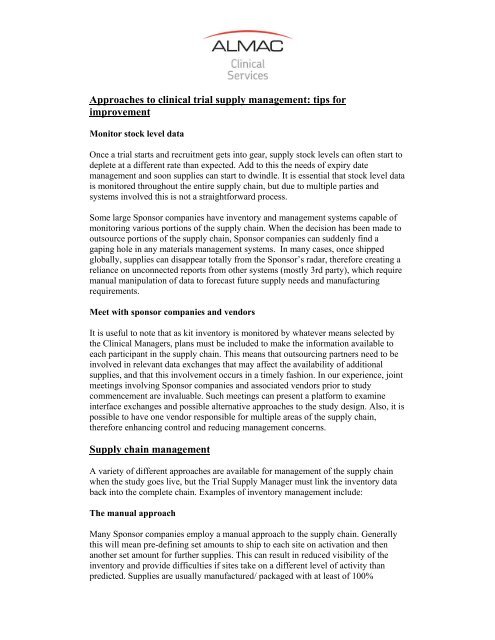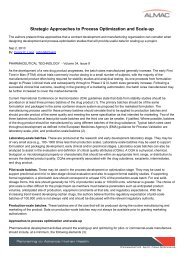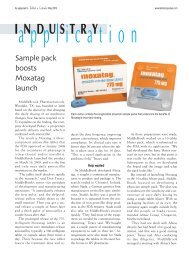The Clinical Trial Supply chain: Best practice to ensure ... - Almac
The Clinical Trial Supply chain: Best practice to ensure ... - Almac
The Clinical Trial Supply chain: Best practice to ensure ... - Almac
You also want an ePaper? Increase the reach of your titles
YUMPU automatically turns print PDFs into web optimized ePapers that Google loves.
Approaches <strong>to</strong> clinical trial supply management: tips for<br />
improvement<br />
Moni<strong>to</strong>r s<strong>to</strong>ck level data<br />
Once a trial starts and recruitment gets in<strong>to</strong> gear, supply s<strong>to</strong>ck levels can often start <strong>to</strong><br />
deplete at a different rate than expected. Add <strong>to</strong> this the needs of expiry date<br />
management and soon supplies can start <strong>to</strong> dwindle. It is essential that s<strong>to</strong>ck level data<br />
is moni<strong>to</strong>red throughout the entire supply <strong>chain</strong>, but due <strong>to</strong> multiple parties and<br />
systems involved this is not a straightforward process.<br />
Some large Sponsor companies have inven<strong>to</strong>ry and management systems capable of<br />
moni<strong>to</strong>ring various portions of the supply <strong>chain</strong>. When the decision has been made <strong>to</strong><br />
outsource portions of the supply <strong>chain</strong>, Sponsor companies can suddenly find a<br />
gaping hole in any materials management systems. In many cases, once shipped<br />
globally, supplies can disappear <strong>to</strong>tally from the Sponsor’s radar, therefore creating a<br />
reliance on unconnected reports from other systems (mostly 3rd party), which require<br />
manual manipulation of data <strong>to</strong> forecast future supply needs and manufacturing<br />
requirements.<br />
Meet with sponsor companies and vendors<br />
It is useful <strong>to</strong> note that as kit inven<strong>to</strong>ry is moni<strong>to</strong>red by whatever means selected by<br />
the <strong>Clinical</strong> Managers, plans must be included <strong>to</strong> make the information available <strong>to</strong><br />
each participant in the supply <strong>chain</strong>. This means that outsourcing partners need <strong>to</strong> be<br />
involved in relevant data exchanges that may affect the availability of additional<br />
supplies, and that this involvement occurs in a timely fashion. In our experience, joint<br />
meetings involving Sponsor companies and associated vendors prior <strong>to</strong> study<br />
commencement are invaluable. Such meetings can present a platform <strong>to</strong> examine<br />
interface exchanges and possible alternative approaches <strong>to</strong> the study design. Also, it is<br />
possible <strong>to</strong> have one vendor responsible for multiple areas of the supply <strong>chain</strong>,<br />
therefore enhancing control and reducing management concerns.<br />
<strong>Supply</strong> <strong>chain</strong> management<br />
A variety of different approaches are available for management of the supply <strong>chain</strong><br />
when the study goes live, but the <strong>Trial</strong> <strong>Supply</strong> Manager must link the inven<strong>to</strong>ry data<br />
back in<strong>to</strong> the complete <strong>chain</strong>. Examples of inven<strong>to</strong>ry management include:<br />
<strong>The</strong> manual approach<br />
Many Sponsor companies employ a manual approach <strong>to</strong> the supply <strong>chain</strong>. Generally<br />
this will mean pre-defining set amounts <strong>to</strong> ship <strong>to</strong> each site on activation and then<br />
another set amount for further supplies. This can result in reduced visibility of the<br />
inven<strong>to</strong>ry and provide difficulties if sites take on a different level of activity than<br />
predicted. Supplies are usually manufactured/ packaged with at least of 100%

















